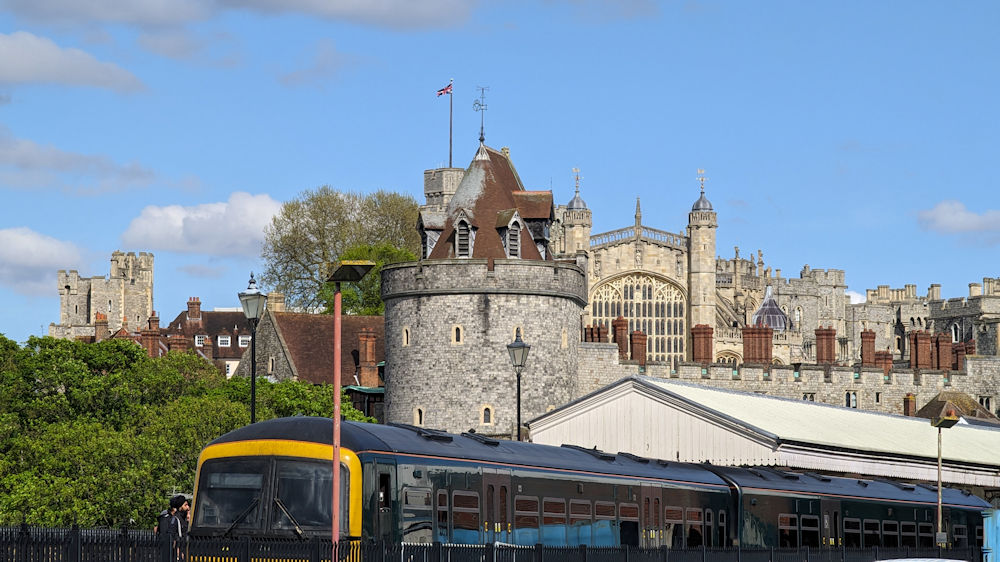
View of Windsor & Eton Central Station and Windsor Castle
8th October 2024 marks the 175th Anniversary of Windsor & Eton Central Station, Royal Branch Line, created by GWR.
On this day in 1849, the first train departed for Slough at 8.05am and there were a further 10 departures, with the last leaving at 9.20pm. The journey time was 6 minutes, the same as it is today.
Have you ever wondered why a relatively small town, the size of Windsor, has two stations?
The team at Windsor & Royal Borough Museum have put together a very informative exhibition, including fascinating photographs and timelines from over the years. This exhibition can be enjoyed, in the Windsor & Royal Borough Museum, at the Windsor Guildhall, in its current opening hours of Tuesdays 10am - 4pm. Or read our blog below for all the information...
The coming of the railways transformed Britain. People and places were better connected over vast distances, and this helped to open up new markets for trade. Like all towns in Britain, Windsor benefited both socially and economically. However, unlike other towns of its size, it gained two separate railway stations – which it still has to this day. This is the legacy of a unique and long-fought railway dispute that unfolded here nearly 200 years ago. The key players were: the Crown; Eton College; Great Western Railway (GWR); South Western Railway (SWR); and the people of Windsor.
Rail mania
The rail revolution in Britain began in the early 19th century following the invention of the steam locomotive by Richard Trevithick in 1804. He proved that steam power could replace horses for moving freight and passengers. Just over 20 years later, George Stephenson pioneered successful rail travel by using his steam engine to pull 21 coaches loaded with 450 passengers along 40 kilometres of track. Stephenson later engineered the Liverpool and Manchester Railway, which opened in 1830 as the first modern railroad.
A network of railways now began to cover the country, linking towns and cities with seaports. Most railway companies raised their capital by forming a joint stock company, meaning individuals bought a share in the company. This was because the investment needed was so large a sum. Railway mania began with many individuals investing their money in hundreds of proposed lines. By 1841, there were more than 2,300 kilometres of track laid down in Britain.
Early railway proposals in Windsor
From 1833 onwards, various schemes were proposed to bring a railway to Windsor. One of the earliest was from GWR who proposed a main line from Reading to London with a branch line running from Slough to Windsor. At the same time, a scheme was proposed by the London and Windsor Railway Company for a direct line from Windsor to London. The later scheme was very popular with local people for the convenience it would provide them.
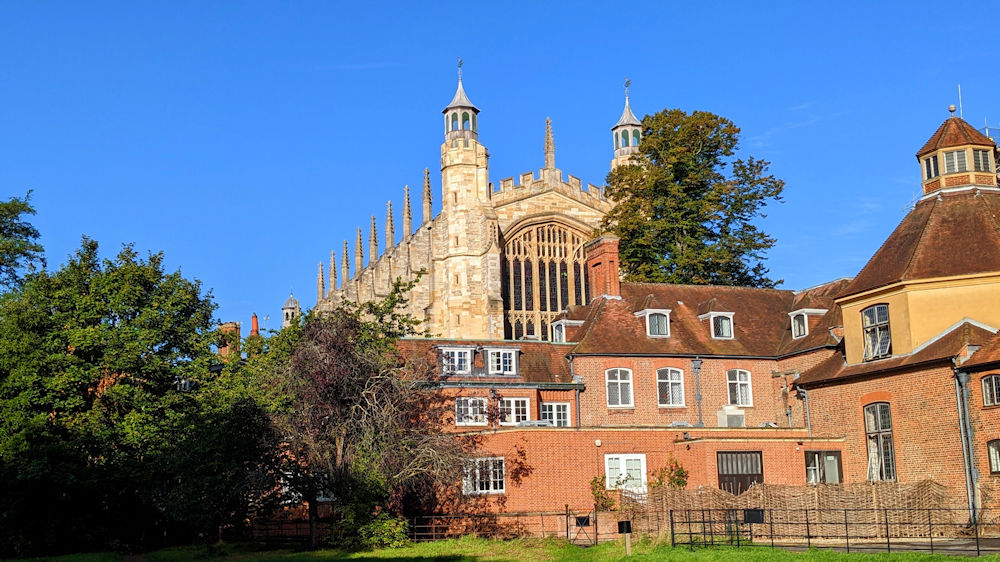
View of Eton College
Eton College objects
Both proposals were met with heavy opposition from Eton College, who feared a railway would mean students could easily escape their control. This, along with financial problems, led to the London and Windsor Railway being abandoned. Eton College had many friends in parliament who continued to block GWR from gaining parliamentary approval. As a compromise, GWR agreed to sacrifice the branch line to Windsor to ensure their main line would pass. They even had to write a clause into their 1835 bill that stated a station would not be built within three miles of the College. This meant a station could not be constructed at either Slough or Windsor.
A peculiar situation in Slough
Almost as soon as GWR started to build its Reading to London line, it was petitioned by residents of Slough and Windsor calling for a station. The Act of Parliament prevented GWR from doing this, but they came up with a loophole, much to Eton College’s dismay.
They simply removed a section of the fence at Slough that protected their railway line and scheduled trains to stop there so people could board from ground level. Passengers booked their tickets at the Crown Inn nearby. Eton College tried take out an injunction this but failed. GWR had not built a station so were not in breach of the terms.
Good news for Slough, not for Windsor
Prince Albert began to frequently use the GWR mainline from Slough to London. This royal endorsement may have softened attitudes at Eton. When GWR wrote to the Provost giving notice of an application to amend the 1835 Act ‘to provide for a station at Slough’, he replied saying he would not consent but would not take any steps to oppose it.
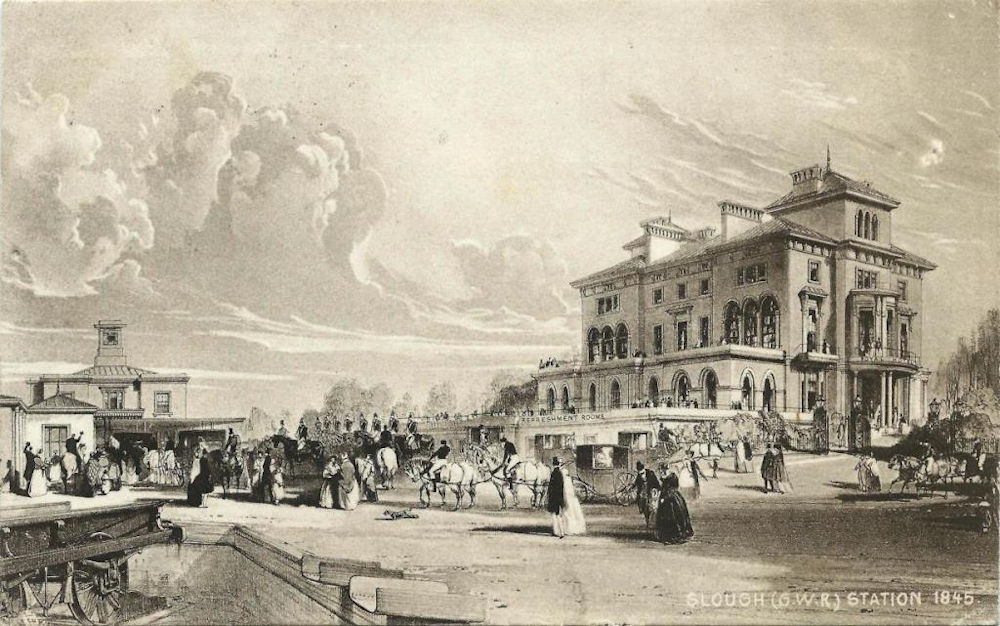
Postcard depicting Slough Station in 1845. Public domain image.
A positive outcome for Slough
Slough Station opened on 4 June 1840 and was built in three months. It was known as Slough and Windsor Station until 1849, and from 1841, the line ran all the way from London to Bristol. The Queen, with Prince Albert, made her first train journey from Slough to Paddington on 13 June 1842. Following this, she began to use the train regularly. For people in Windsor, Slough remained their main gateway to the outside world. However, this still required a trip by road to get there. For convenience, they wanted a station closer to home. Many also felt it would increase tourism trade to the town which in turn would bring great economic benefits.
The fight continued in Windsor
Proposals to connect Windsor to the railway network continued to be made by various railway companies, including by the Windsor Junction Railway and the Windsor, Slough and Staines Atmospheric Railway. These companies did not last very long, and ultimately, all their shareholders and directors joined either with Great Western Railway (GWR) or South Western Railway (SWR).
Can they be persuaded?
Great Western Railway (GWR) and South Western Railway (SWR) began to draw up plans for their railway routes into Windsor. However, if they were to get approval, they would need to find ways to appease the concerns of their two main opponents.
Objections of Eton College
They felt that a railway station nearby would lead to schoolboys escaping the control of school authorities and boarding trains to London to engage in vice. They believed this would damage the reputation of the school because they could no longer guarantee the safety of the boys to their parents.
Objections of the Crown
Queen Victoria wanted privacy and worried that a railway would bring the lower classes to Windsor and crime might increase. She also thought the engines would pollute the air and make the castle walls dirty. She was further concerned that an engine shed would be an eyesore and vibrations might damage the castle.
There were a few circumstances, however, that the railway companies could exploit in their favour. Eton College had begun to speak with two voices. Although the school masters still strongly opposed, the governing body was becoming more amenable. They had witnessed the traffic caused by people travelling from Windsor to Slough Station and felt this caused a greater risk to the safety of the boys. The evils they had anticipated from the opening of Slough Station had also not materialised, making them feel that their concerns might have been unfounded.
In regards to the Crown, it was felt by 1846 that Windsor Castle was in need of renovations. However, the last refurbishment, between 1824and 1836, had cost over a million pounds. There had been a great deal of public criticism about this, so it was felt that for the next refurbishment, money could not be spent from public funds. The Crown spotted an opportunity. If the railways were willing to pay a significant sum for the privilege of crossing the Crown Estate, then the money could be used to pay for the much-desired renovations.
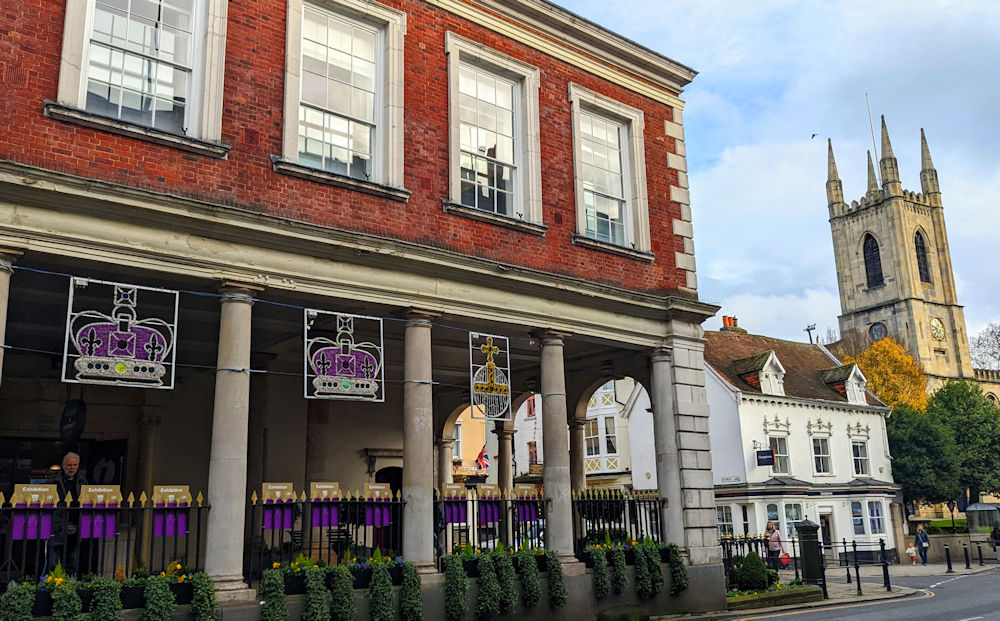
Windsor Guildhall
A showdown at Windsor Guildhall
Support in the town was split between the two remaining railway companies, with some preferring a station in the centre of town (proposed by GWR) and others preferring a direct route into the centre of London (proposed by SWR), even if it meant having the station in Datchet. The Mayor of Windsor, Mr James Bedborough, decided to call a public meeting for local residents to discuss the pros and cons.
A fiery debate
The public meeting was held on 7 December 1846 at Windsor Guildhall and was chaired by Bedborough. The stakes were high for the railway companies and after hearing about the meeting, they sent their staff and interested parties to fill the Guildhall. The GWR even arranged for a special train (via Slough) to transport their staff to Windsor. The room was so crowded that local residents were prevented from entering to have their say. In the words of the Windsor & Eton Express, the meeting became ‘stormy’ as representatives from both companies strongly advocated for their respective lines.
In a turn of events, the representative of the GWR asked the Mayor to sign a petition stating that their proposal was favoured by the town. Mr Bedborough refused saying that the meeting was not representative of local people. Though, it must be acknowledged that Mr Bedborough himself had interests in the South Western Railway, and the Town Clerk, Henry Darvilll, was the solicitor for GWR.
Bedborough declared that he would place a petition at the Guildhall that could be signed by residents only. In the end, 14 signed for the adoption of the GWR proposal and 238 against. Residents might have spoken but it was up to parliament to decide the outcome, and GWR were not giving up.
Finally there? Time for parliament to decide
Both GWR and SWR brough their proposed bills before parliament in 1847. The GWR bill was quickly thrown out because of the strong opposition from Eton masters. However, the SWR bill passed on 25 June 1847 and the company committed to paying £60,000 towards a town improvements bill that would help to pay for renovations in Windsor. The crown pledged support for the GWR branch if they paid a further £25,000 towards the improvements.
Last hurdles for GWR
The GWR bill came before parliament again in March 1848 and former Etonian, William Gladstone (later Prime Minister), represented the objections of the school masters. However, at a Commons Select Committee two months later, GWR announced that the Provost and Fellows of Eton had signed an agreement in support of the building of the line. They had worked with GWR to select a railway route in the Eton area that would be acceptably far enough from the boundaries of Eton College. Isambard Kingdom Brunel (GWR’s Chief Engineer) stated at the Committee that the building of the station would clear an area of the ‘lowest, dirtiest, worst drained and ventilated streets in Windsor’. The Crown also approved of the site. A petition was later submitted in favour of the GWR Bill which was signed by 780 rate-paying inhabitants in Windsor, including the Dean and Mayor.
The Bill received its third reading at the House of Commons in late June. This time, Benjamin Disraeli (also future Prime Minister) represented the objections of the school masters. Despite his lengthy speech, the bill passed with a majority of 127.
Jubilation in Windsor
The news was announced to the citizens of Windsor by the ringing of Bells at Windsor Parish Church. Royal Assent was received on 14 August 1848; the same day as a Town Improvement Bill. Following the success of GWR, the South Western Railway were also given permission to extend their line into Windsor and build a station in the town.
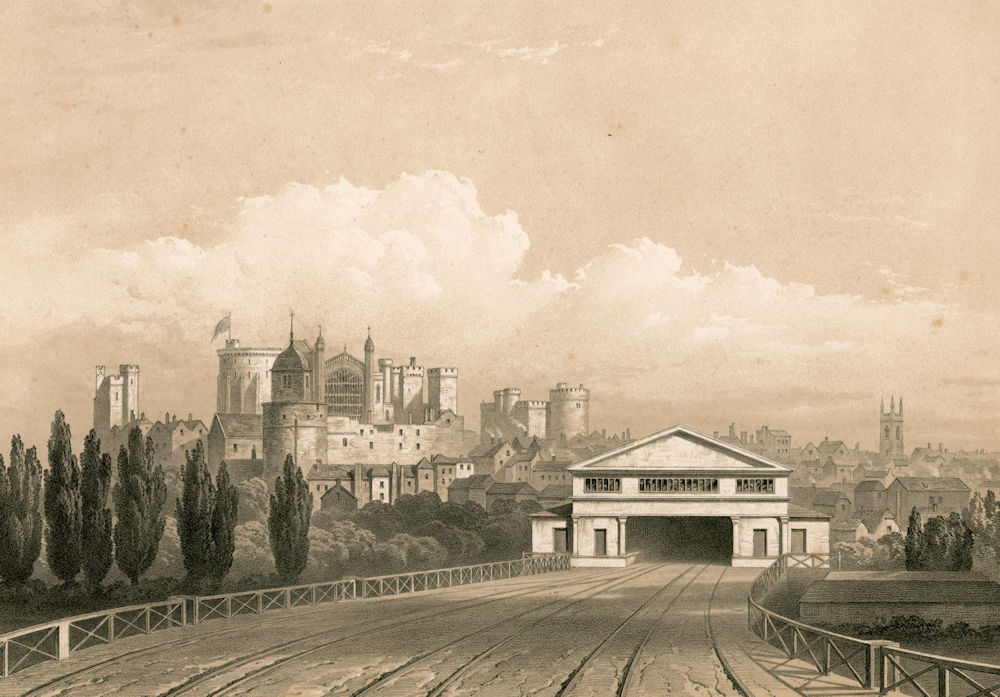
Lithograph of Windsor Central Station (GWR) in 1851, WNDRB: 28.1
Great Western Railway versus South Western Railway. Who won?
SWR opened its station at Datchet on 22 August 1848. However, their extension to Windsor was severely delayed on 14 August 1849 when a cast iron girder of their bridge across the Thames at Black Potts snapped. This was caused by the sinking of one of the piers. The engineer, Locke, under pressure to complete the line quickly, had built the pier on cast iron cylinders; a method he had not used before. This happened the day before the SWR bridge was to be inspected prior to opening. This delay meant GWR won the race. The GWR bridge was complete in September 1849 and inspected by the Board of Trade on 5 October. GWR station opened their station on Monday 8 October, and SWR opened theirs nearly two months later on 1 December 1849.
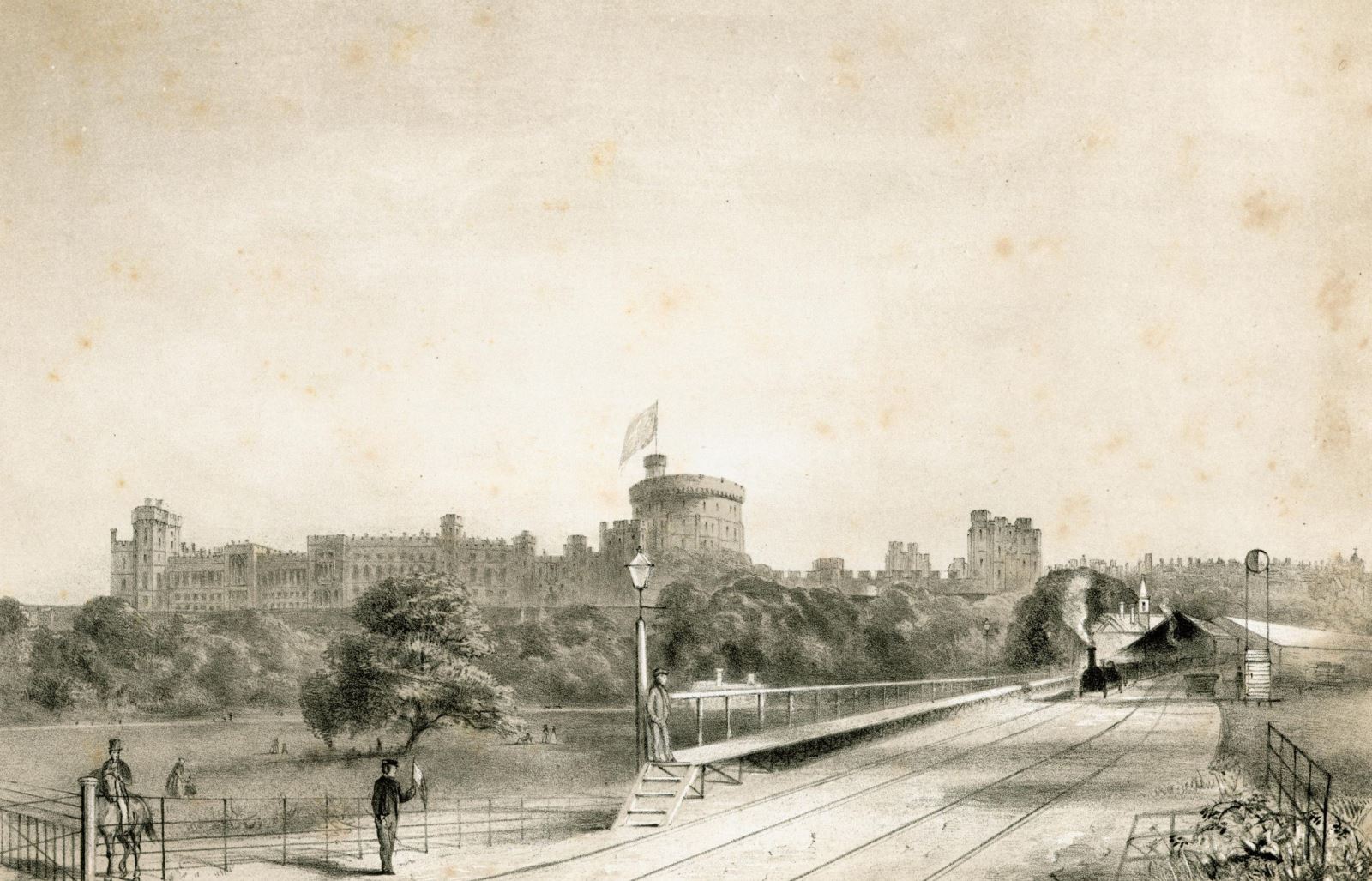
Lithograph of Windsor Riverside Station (SWR) in 1851, WNDRB: 29.1
A 175 years of service
Both of Windsor’s stations have been an essential part of the Town’s infrastructure since their opening 175 years ago. They have enabled generations of residents and visitors to go about their daily activities, from commuting to work to seeking leisure trips. The railways have carried people to Windsor for numerous historic events, including the golden and platinum jubilees of Queen Victoria and Queen Elizabeth II; Olympic events in 1908, 1948 and 2012; and for the funerals of five monarchs.
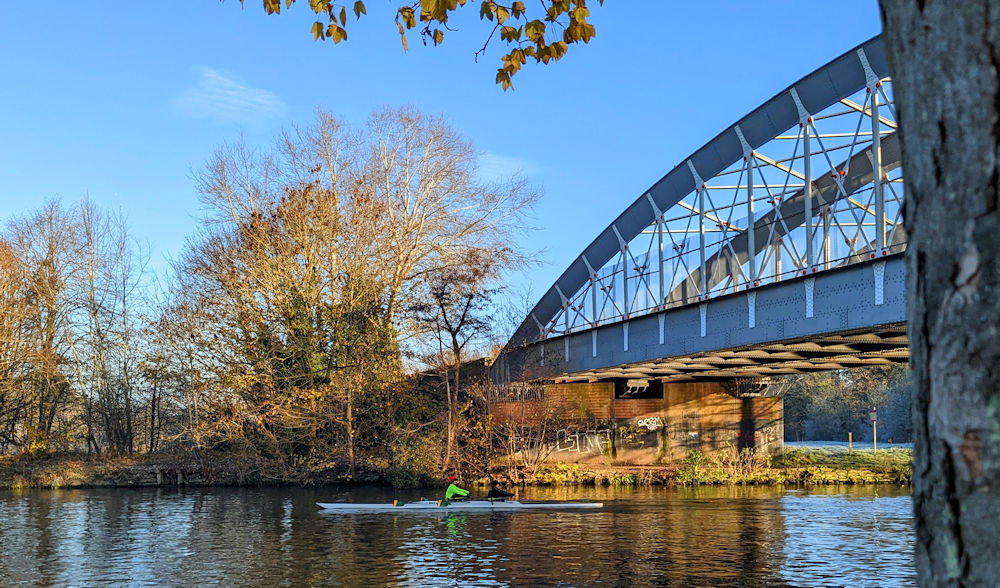
Railway bridge over the River Thames
A continuing legacy
The stations and railway lines have gone through various renovations during this time. They have both been electrified; been subject to proposed route alterations; and in the case of GWR, their station was completely rebuilt in 1897 to celebrate Queen Victoria’s Jubilee.
Through it all, however, generations of staff have worked to ensure the original vision of those who advocated so tirelessly for the railways to come to Windsor.
Related
Comments
Comments are disabled for this post.




 to add an item to your Itinerary basket.
to add an item to your Itinerary basket.















Comment removed by Post Author
Comment removed by Post Author
Comment removed by Post Author
Comment removed by Post Author